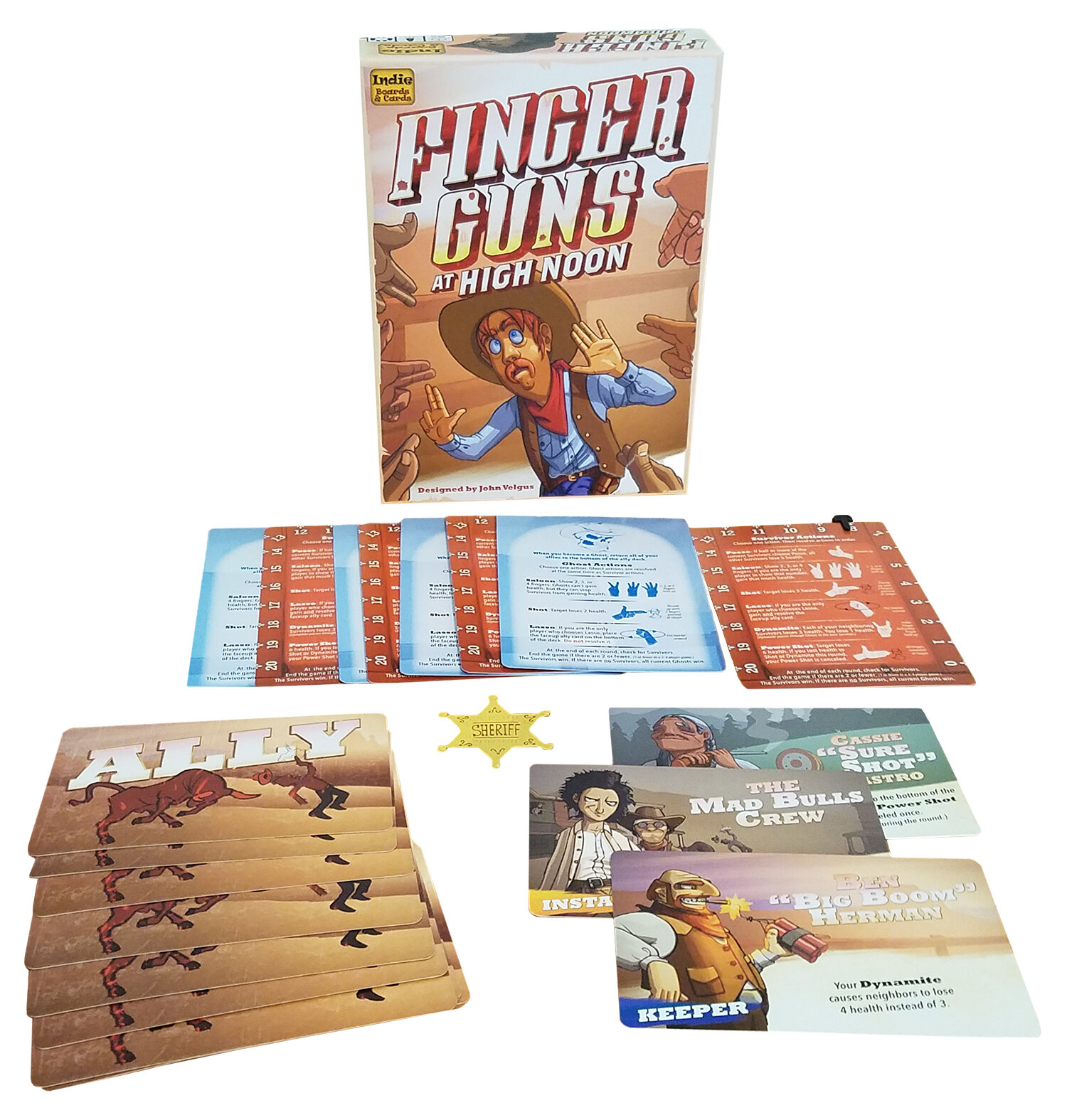Finger Guns at High Noon
About
3-8 Players | 20 minutes
Category: Party Game
Mechanisms: Simultaneous Action Selection
Finger Guns at High Noon, designed by John Velgus and published by Indie Boards and Cards, is a fast-paced game of strategy, negotiation, and pure hilarity. In the game, you are competing finger gun slingers with a score to settle. Can you survive the chaos?
Craft your plan, convince the crowd to join in, then count down and draw your finger guns. Hand gestures show everyone’s actions and targets. Eliminate players with pistols, dynamite, and power shots, round up a posse, heal up in the saloon, or lasso up an ally card for a special power. Last player standing wins – unless the ghosts eliminate everyone.
SERVICES PROVIDED
Game Design
Content Design
PROJECT OVERVIEW
I am the designer of Finger Guns at High Noon and created the game from concept to fine-tuned prototype. The final version of the game from the publisher was very similar to what I submitted in terms of gameplay and content – a result of heavy play testing and careful tinkering.
While this is a fairly simple game, there was a ton of work to deliver the polished experience. The types of player actions, and their activation order, are incredibly important and went through many iterations. Math was tricky in this game, as I wanted to keep it simple for players, yet working with such small numbers meant balance had to be super tight. A difference of just 1 damage can ruin player incentives and pacing of the game. Creating the Ally cards was a great way to add some surprise and replayability to the game, as well as give it a lot of lighthearted wild west personality.
Project Highlight: Encouraging Socialization
A key aspect of party games is encouraging and managing social interaction. In Finger Guns at High Noon, social interaction is most apparent in the Discuss and Draw phase. In this phase, players are free to talk, persuade, and negotiate as they see fit, doing their best to influence the game before the finger guns start flying. A key design hurdle was making social interaction engaging and meaningful. This was addressed through clear incentives, open discussion, and a flexible discussion duration.
The most important part of encouraging players to socially interact is tying it to gameplay incentives. Basically, socializing should help players win. This was mainly achieved by designing game actions with a lot of counterplay and group dynamics. For example, the Posse action activates if half or more of the survivors choose Posse, then all other survivors lose 5 health. This powerful action requires player coordination and comes at a significant risk as it is all or nothing, incentivizing a player to convince others to join them. For games that are five or more players, it is possible to have two Survivors win the game, giving a strong incentive to work with (or betray) another player when the opportunity arises.
A method of open discussion was needed to suit different player types. An early decision was that discussion would be free-form and players were not required to talk. A key aspect to keeping this discussion engaging was to make everything non-binding. First off, this was done for practical reasons. It is way too difficult and not fun to clarify and track what each player discusses. More interestingly, this created some engaging conversations and tension. Players are encouraged to mislead and lie just as much as they are to cooperate. This is always entertaining to watch and still provides less talkative players valuable information to base their decisions on.
The final major area of encouraging and managing social interaction was timing. What is the optimal amount of time players should be able to have an open discussion? The answer of course is it depends. Some players like to discuss at length, others could care less and just want to start shooting fingers at each other. Different play groups have different discussions. Even round to round can vary a lot as situations change and players adapt. After much exploration, the solution I came up with was the discussion phase ends whenever ANY player wants just by calling out “Three, Two, One, DRAW!”. This reinforced the quick gameplay and tension I wanted while adding some more surprise and emotional moments to the game. It also had an interesting side benefit in that some players would use this interruption tactically when they sensed the discussion not going their way. To avoid one player dominating the game by continually cutting the discussion phase short, a player can never end a discussion phase twice in a row (kept track of by having the player hold onto the spiffy sheriff badge).
PRAISE for Finger Guns at High Noon
Top Party Game of 2019 – Dan King, GameBoyGeek
“This is John Velgus’ rookie design and boy did he hit a homerun. Finger Guns At High Noon is so simple to teach and super accessible at the table. There has not been one single instance of me playing this game where someone does not say, let’s play that again.” - Punchboard Media
“And I think my favorite thing about it was that the game actually encourages you to table talk. Like you can be let’s kill Randy. He needs to go!” - Ellen Kirby, The Dice Tower


